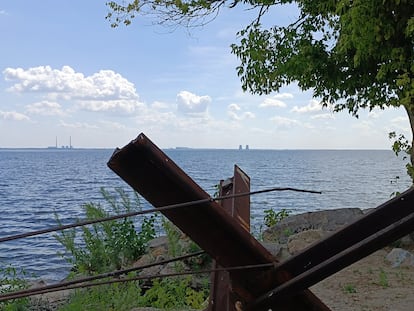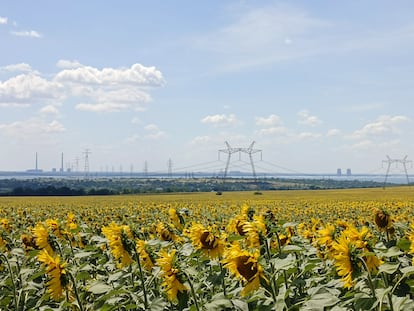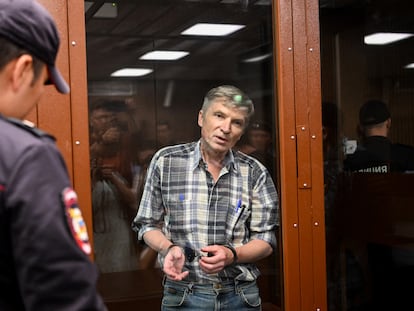The spoils of war: How Russia is leveraging Europe’s largest nuclear power plant
The Russian Army is storing weapons at the Ukrainian facility in Zaporizhia and preparing a plan to connect it to its own electricity grid


Separated by a few miles of water, Russian and Ukrainian soldiers watch each other through binoculars. A small detachment of the Ukrainian Army is stationed in the village of Illinka, on the western bank of the Dnipro River in southern Ukraine. Across the river stands Europe’s largest nuclear power plant – Zaporizhzhia. According to the Ukrainian Defense Ministry, more than 500 Russian soldiers, 50 military vehicles, ammunition, and artillery batteries are positioned in the plant.
The captain of the Ukrainian unit stationed in Illinka says they don’t have the heavy weapons to defend against Russian artillery attacks. This is the first time, he says, that any reporters have come here. There are danger signs alerting people to the mines placed along the riverbanks to defend against an invasion from across the river. Our interview proceeds quickly, as the presence of journalists with visible press credentials could attract unwanted attention from the Russian forces watching from the other side. As we talk to the captain, a plume of smoke rises from the occupied side of the river – the Ukrainians are shelling Russian positions about six miles (10 kilometers) from the nuclear power plant.
The Russian invaders captured the Zaporizhzhia power plant and its environs in March. The images of bombs hitting the nuclear facilities sparked a wave of international indignation. The largest nuclear catastrophe in history occurred in Ukraine in 1986, when a reactor at the Chernobyl plant exploded.

On July 20, the Ukrainians launched a kamikaze drone against Russian units positioned near the nuclear power plant. The DiXi Group, a Kyiv think tank focused on the Ukrainian energy sector, confirmed the “precision [drone] attack.” According to Energoatom, the Ukrainian state-owned company that still manages the Zaporizhzhia plant, the Russians countered by storing “14 pieces of heavy weaponry, ammunition, and explosives,” inside the turbine room of one of the reactors.
Russia routinely shells Nikopol from Enerhodar, the city that surrounds the Zaporizhzhia power station. Ukrainian commanders prevented EL PAÍS from entering Nikopol on July 24, citing the Russian bombing, although other civilians were allowed to come and go freely that day.
Energoatom staff threatened
Energoatom employees in Zaporizhzhia work in partial freedom. Rafael Mariano Grossi, director general of the International Atomic Energy Agency (IAEA), recently expressed “… growing concern about the difficult conditions facing the workforce.” The Russians intend to take over the plant’s operation in September and connect it to their own power grid. Zaporizhzhia provides 20% of Ukraine’s electricity.
In May, Ukrenergo, the public company that manages Ukraine’s electricity grid, stated, “Ukraine’s power system currently has no physical connections with Russia’s power system. Therefore, the supply of electricity from Ukrainian power plants to Russia is currently physically impossible.” However, according to a map from the European Network of Transmission System Operators for Electricity (ENTSOE), Ukraine not only has direct high-voltage connections with Belarus and Russia, but the country’s grid is also connected to Crimea, the Black Sea peninsula that was illegally seized from Ukraine and annexed by Russia in 2014. Crimea is connected to Russia with high-voltage power lines, and all of these transmission lines run through Russian-controlled territory.
Energoatom and Ukrenergo would not specify to EL PAÍS what would prevent connecting Zaporizhzhia to the Russian power grid. Eugeni Panov, a retired employee of the plant, stays in touch with former colleagues still working there. He says that Ukrainian forces knocked down the pylons supporting the high-voltage transmission lines to Crimea when the Russians captured Zaporizhzhia. Panov acknowledges that repairing these pylons “isn’t difficult,” but assumes that the Ukrainian army would just knock them down again. Meanwhile, Energoatom spokesperson Leonid Olinik told the BBC in May that the Zaporizhzhia plant “… only works with the Ukrainian power line. The Russians could theoretically build another power line, but that would take several years.”
Yuri Vitrenko, president of the Ukrainian state natural gas company Naftogaz, met with US congressional representatives in June and said that Moscow “… is trying to disconnect the plant from the Ukrainian power grid and connect it to Russia’s grid.” Vitrenko did not say it was impossible, but claimed that it would be “very dangerous… No one can guarantee that something catastrophic will not happen.” Oleh Korikov, chairman of the Ukrainian Nuclear Energy Authority, explained why this would be dangerous in a June statement. “The main concern is that the [nuclear] fuel will cool down when the power supply is interrupted. If power is not restored immediately and cannot be repaired, radioactive fuel could start leaking and eventually lead to an accident.”

Lluís Batet, professor of nuclear engineering at the Polytechnic University of Catalonia (Universidad Politécnica de Cataluña) in Barcelona (Spain), agrees that it’s a fragile situation, but believes that if the high-voltage transmission lines appearing on the ENTSOE map remain operational, connecting Zaporizhzhia to the Russian grid shouldn’t be problematic. “They would need to shut down power at the plant, synchronize it with the Russian grid, and then bring the power back up again. Grid disconnection and reconnection is a procedure that nuclear power plants routinely perform once or twice a year.”
Korikov claims that the Russian blockade of the plant has prevented shipments of spare parts such as valves and other components from getting through, but Batet thinks that Russia could just as well supply these spare parts. The Zaporizhzhia plant was built in the 1980s when Ukraine was still part of the Soviet Union, and began full operation in the 1990s after Ukrainian independence. Former Zaporizhzhia employee Eugeni Panov says that the plant’s technology is more advanced than in other Russian plants, so their engineers are still learning how to operate it. Ukrainian intelligence services claim that the Russian government is trying to attract technicians to Zaporizhzhia with very lucrative work and retirement conditions.
The IAEA has requested access to the plant for its inspectors, a demand so far ignored by the Russians. Ukrainian authorities are also against an IAEA visit because they cannot guarantee the safety of the inspectors. “The reports coming in are very worrisome and point to the importance of the IAEA gaining access to the plant,” said IAEA Director General Grossi. “It is extremely important that no action is taken that would put the plant at risk.”
Three of Zaporizhzhia’s six reactors are currently operating. The plant’s installed power capacity is six gigawatts – Spain’s entire nuclear power capacity is seven gigawatts. “Chernobyl would be child’s play compared to what might happen here,” said Eugeni Panov. Missiles were not launched over Chernobyl every day. Russia’s seizure of the plant is nuclear terrorism, says the Ukrainian government.
Tu suscripción se está usando en otro dispositivo
¿Quieres añadir otro usuario a tu suscripción?
Si continúas leyendo en este dispositivo, no se podrá leer en el otro.
FlechaTu suscripción se está usando en otro dispositivo y solo puedes acceder a EL PAÍS desde un dispositivo a la vez.
Si quieres compartir tu cuenta, cambia tu suscripción a la modalidad Premium, así podrás añadir otro usuario. Cada uno accederá con su propia cuenta de email, lo que os permitirá personalizar vuestra experiencia en EL PAÍS.
¿Tienes una suscripción de empresa? Accede aquí para contratar más cuentas.
En el caso de no saber quién está usando tu cuenta, te recomendamos cambiar tu contraseña aquí.
Si decides continuar compartiendo tu cuenta, este mensaje se mostrará en tu dispositivo y en el de la otra persona que está usando tu cuenta de forma indefinida, afectando a tu experiencia de lectura. Puedes consultar aquí los términos y condiciones de la suscripción digital.
More information
Últimas noticias
Maduro pleads not guilty before the federal court in New York: ‘I am still the president of Venezuela’
A new test can detect Alzheimer’s from a finger prick
UN team enters Sudanese city of El Fasher after paramilitary massacre: ‘It’s like a ghost town’
A recipe for resistance: Indigenous peoples politicize their struggles from the kitchen
Most viewed
- Gilles Lipovetsky: ‘If you want to live better and fall in love, take Prozac, don’t look to philosophy’
- Alain Aspect, Nobel laureate in physics: ‘Einstein was so smart that he would have had to recognize quantum entanglement’
- Alvin Hellerstein, a 92-year-old judge appointed by Bill Clinton, to preside over Maduro’s trial in New York
- Why oil has been at the center of Venezuela-US conflicts for decades
- Maduro’s downfall puts China’s relationship with Venezuela to the test










































